
Gold sheen Obsidian is a captivating variety of volcanic glass distinguished by its dark black base with golden, shimmering inclusions. Formed from rapidly cooled lava, this natural glass has been revered for centuries for its mystical and protective properties.
Why it is called Gold Sheen Obsidian
The name “Obsidian” originates from the Latin term obsidianus, derived from the Roman explorer Obsius, who believed to have discovered the first specimens in Ethiopia. Gold Obsidian gets its name from its unique golden sheen, which results from gas bubbles and mineral inclusions trapped within the cooling lava.
Locations and Geological Occurrence
Gold Obsidian is primarily found in regions with significant volcanic activity. Major sources include:
- Mexico – Home to some of the finest Gold Obsidian specimens, often used in ancient and modern spiritual practices.
- United States (Oregon, California, Arizona, and Idaho) – Known for high-quality obsidian deposits with various sheens, including gold and silver.
- Guatemala – A source of high-grade obsidian used by the ancient Maya.
- Peru – Contains notable deposits, often associated with Incan artifacts.
- Japan – Certain volcanic regions produce distinctive Gold Obsidian specimens.
- Armenia and Turkey – Historic sources of obsidian, including varieties with golden shimmer.
Archaeological Finds and Historical Records of Use
Gold Obsidian, like other obsidian varieties, has been used throughout history for practical and ritualistic purposes. Significant archaeological discoveries include:
- Mesoamerican Civilisations (Aztecs and Maya) – Obsidian was carved into mirrors, weapons, and ritual tools. Gold Obsidian was particularly valued for its perceived spiritual properties.
- Ancient Rome and Greece – Used in jewellery, scrying mirrors, and decorative objects.
- Native American Artifacts – Tribes in North America utilised obsidian for arrowheads, knives, and ceremonial objects.
- Incan Empire – Gold Obsidian was believed to be a conduit for spiritual wisdom and protection.
Folklore, Legends and Tales
Gold Obsidian has long been associated with mysticism, protection, and transformation. Some notable legends include:
- The Mirror of Truth – In Mesoamerican cultures, obsidian mirrors, including Gold Obsidian, were used by shamans for divination and spiritual insight.
- A Warrior’s Guardian – In many traditions, Gold Obsidian was believed to shield warriors from harm and negative energy.
- The Gateway to Hidden Knowledge – Some legends claim that staring into Gold Obsidian could reveal hidden truths or past-life memories.
- The Stone of Ancient Fire – Myths suggest that Gold Obsidian carries the energy of volcanic fire, symbolising transformation and renewal.
Astrological Connections
Gold Obsidian is linked to celestial forces and is commonly associated with:
- Zodiac Signs – Sagittarius and Scorpio – These signs benefit from Gold Obsidian’s grounding and transformational energies.
- Planetary Influence – Pluto and the Sun – Pluto represents deep transformation, while the Sun enhances confidence and clarity.
- Elemental Connection – Fire and Earth – Represents grounding, protection, and spiritual awakening.
Chakra System and Energy Healing
Gold Obsidian is considered a powerful healing stone for:
- Root Chakra (Muladhara) – Provides grounding and stability, protecting against negativity.
- Solar Plexus Chakra (Manipura) – Enhances self-confidence, willpower, and personal growth.
- Third Eye Chakra (Ajna) – Aids in deep meditation, spiritual insight, and intuitive development.
Energy healers use Gold Obsidian for:
Shielding against psychic attacks and negative vibrations.
Removing energy blockages and negative influences.
Strengthening one’s ability to face truth and self-reflection.
Enhancing meditation and past-life exploration.
